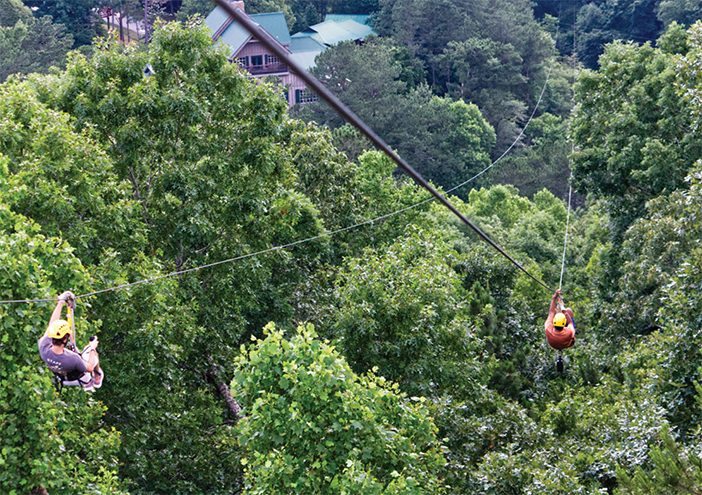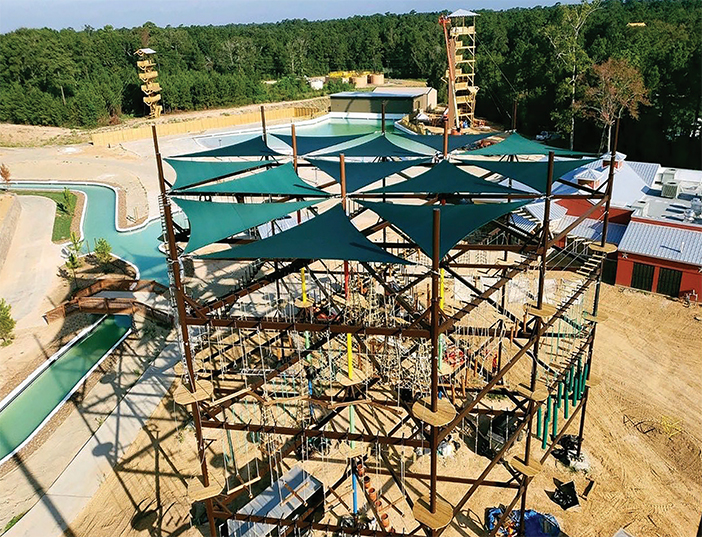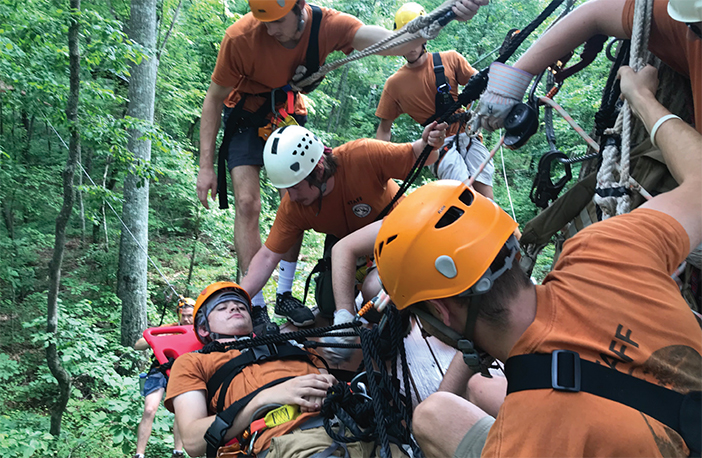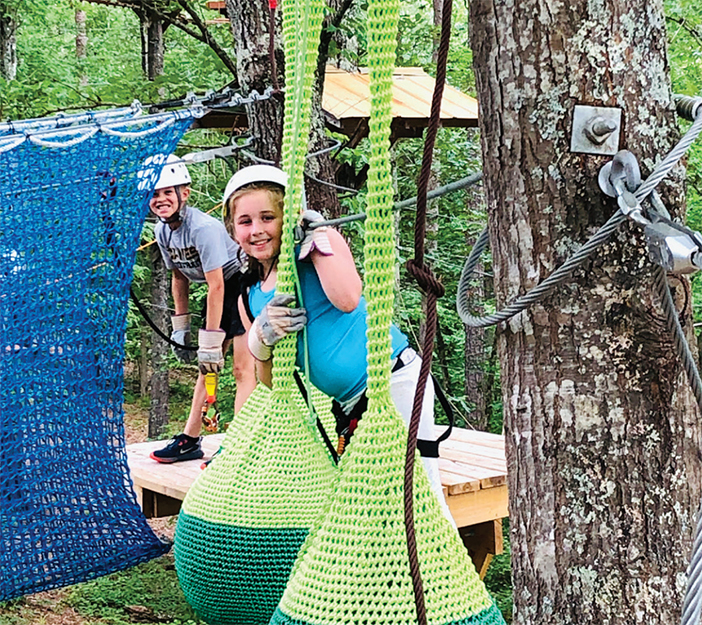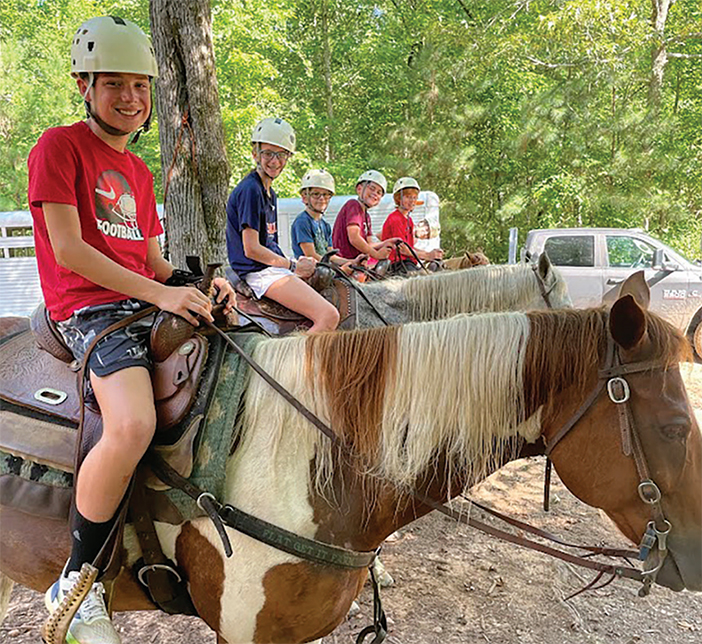Mike and Donna Holder had well-established careers as a commercial airline pilot and registered nurse, respectively, prior to buying an abandoned, overgrown parcel of land about 45 minutes southwest of Atlanta back in 1997. Brush clearing revealed the bones of an abandoned mill town, and historic preservation became central to their plans for a bed & breakfast to host team-building retreats on the property. What began in 1998 with a single zip line to support the team-building program has grown into a superlative adventure resort—Historic Banning Mills— and its subsidiary design, build, supply, and consulting firm, American Adventure Park Systems.
That first zip line wasn’t built on a whim, though. Mike spent 35 years as a high element facilitator, and he had decades of experience building and working on zip lines before zip lines were considered a fun thing to do. As an Army Ranger, he built zip lines and was a trainer on them starting in the mid- ’70s.
With their backgrounds in the military and medical fields, the Holders have always prioritized safety. Mike and Donna were involved in developing industry standards early on. American Adventure Park Systems was established as a means of helping others build safer aerial attractions.
As the size and scope of their business has grown, the Holders have remained true to their focus on preservation: Their entire enterprise is a nonprofit with a conservation mission. Today, Historic Banning Mills holds the Guinness World Record for the world’s largest zip line canopy tour (the Screaming Eagle) and tallest freestanding artificial climbing wall—just two of the park’s many features, which include hiking, kayaking, horseback riding, ATV tours, a ropes course, lodging, dining, and the preserved ruins of the 19th century Banning Mills community. The Holders have also partnered with states and other nonprofits to build and operate 10 other Screaming Eagle adventure parks in the Southeast.
API sat down with Mike and Donna to talk about the company’s history, evolution, and unique mission.
API: Tell us how you got started in the adventure park business.
Mike Holder: I was actually flying full time for an airline, plus I was in the military. My background had a lot to do with zip lines, but they were combat zip lines, not something you played on. I’ve been building them since 1975. That’s probably longer than most people. We actually gave combat zip line Ranger demonstrations at Fort Benning for President Gerald Ford, so I really just dated myself big time.
We had just found Banning Mills. It was an abandoned town and we saw that it had an unbelievable amount of potential, not only for history and conservation, but everything from youth retreats to the military to couple’s retreats. But nobody was really doing zip lines in the United States, except a couple of little team-building zip lines and things like that. I got a couple of people to work with me that had done some zip lines, but they hadn’t done anything big.
Donna Holder: Banning Mills started out as a 10-room bed and breakfast. We were doing team building, and Mike was flying down to South America and they were starting to use zip lines just for fun. And when he came back, he said, “We’re going to do this.”
Mike: And it was crazy down there. They were braking with sticks.
Donna: So, we incorporated that into the team building, and that’s when we began to expand in phases.
Mike: We started up and people watched us for about four or five years and they thought we were going to kill everybody [laughs]. But customers kept coming back, and they had such a great time. Then, zip lines started being built all over the world. So, we just kept adding more and more, and before you know it, we had a zip line canopy tour here and it ended up being the largest in the world, and we’ve held that record since 2012.

Historic Banning Mills offers a variety of overnight accommodations, including the unique Treehouse Lodges.
API: The company is a nonprofit. How did that come about and how does it work from a business standpoint?
Mike: We did not want to go out and have to ask people for money every year or quarter trying to do fundraisers, things like that. It’s a nonprofit, yeah, but it’s run as if it was for profit. We have up to 250 employees; we didn’t want to have to ask for money to pay them. It’s worked out very well for 20 years.
There’s a misconception about what a 501(c)3 is and how they support themselves. We’re a self-supporting conservancy nonprofit, and we work to preserve other places like ours. We work with nonprofits all over the world to do the adventure side of things. We use their trees to help save their parks. We are able to give sometimes very substantial discounts, usually in the range of 30 to 40 percent.
Donna: As a self-supporting nonprofit, the money all goes back to the conservancy. So, we’re here to preserve not only the ecosystem of the Snake Creek Gorge [at Banning Mills], which is really unique, but also the historic aspect as well.
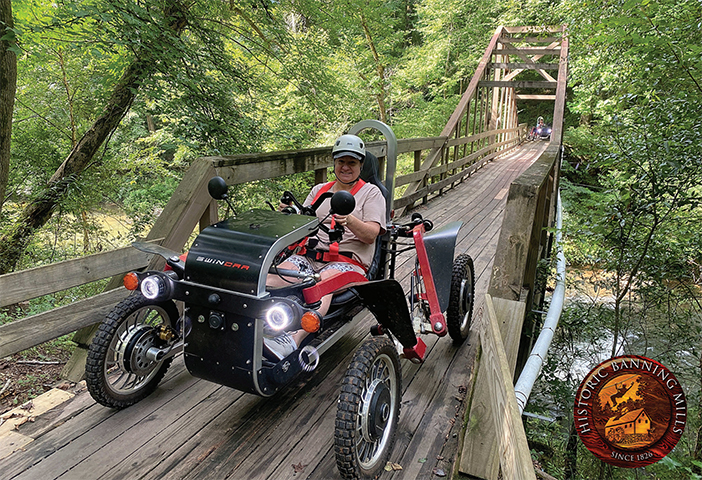
Historic Banning Mills intorduced Swincar e-Spider ATV’s in part because guests with limited mobility can operate them.
API: You both had established careers. Was this supposed to be a second career, or your semi-retirement? Did it start with acquiring Banning Mills, and then looking around at the potential of the property?
Mike: It was a combination of all those things you just said, but it didn’t start out looking for a piece of property to do this. We found this piece of property and it was so unique and had so much history. It was a piece of property that you didn’t need to develop. It needed to be kept as close to natural as possible.
Donna: We were trying to figure out a way we could preserve it, and that’s kind of why we went the way we went. We started with the team building and then it kind of morphed into an adventure resort because we had the acreage where we had the ability to do the aerial zip lines. We later added the climbing, kayaking, horseback riding.
API: Banning Mills has a huge variety of activities and amenities—zip lines, ATV tours, kayaking, summer camps, lodging, dining, etc. Why is it important to diversify your operations?
Donna: When someone comes onto the property, they may not be able to do an all-day zip line tour, but they could go hike on the trails. Also, we work a lot with the military and with the Wounded Warrior Project, so we see some paraplegics and that was one of the reasons we got the Swincar e-Spiders—they can actually transfer from a wheelchair into a Swincar and go out on the trails and enjoy nature. You only need one hand to accelerate and brake.
And we have the Crazy Squirrel Aerial Course, which, for example, allows a four-year-old to play while an older sibling goes out on an all-day zip line course. We have a lot of different opportunities for people if they stay here two or three days. They might want to zip line one day, kayak another day.
API: Over the years have you introduced an activity that has not worked?
Mike: We had an archery course here at one time, and skeet shooting. We found that the shooting didn’t go with the other adventure stuff at all. Also, we used to do tons of weddings and we found that the more adventures we had going on, the fewer weddings we did because there were noises the weddings didn’t want to hear.
Donna: A couple doesn’t want to hear someone screaming in the trees while they’re saying, “I do.” So, we’ve migrated totally over to the adventure experience.
API: Tell me about the mix of recreation and team-building in your business model.
Mike: At first it was just going to be hospitality oriented. But we started thinking we wanted things for people to do, for the corporate groups to do, especially team building, which we were really oriented around. My thought was to reward them. They have a nice place to stay, a room with a jacuzzi and stuff like that. And they’ve been out in the woods and doing hot, messy team-building all day long, and then they get to ride zip lines all the way back to their room.
Donna: You can’t put all your eggs in one basket. We saw that with Covid; we lost all of our rooms, all the groups, but we were able to continue with the outdoor adventure.
API: How do you view and prioritize safety and risk in your operations?
Mike: To help mitigate risk, we really got involved with continuous belay systems. With hundreds of thousands of people going through our courses, sooner or later mom is going to bump junior off a platform, and I have sweats at night thinking about that. So, we found this guy who came from the power industry in France, and he has been developing a continuous belay system [Vertical Trek Innovations] for people working on power lines. It’s a tough, viable, and cost-effective system—we won’t build a course without that system being applied. I don’t worry about participants anymore; I worry about the guides because those guys still have to be able to move around.
Donna: It actually opens opportunities for younger kids to get onto aerial courses. With a continuous belay system, you don’t have to worry about them falling off. Also, our guides are CPR trained, high rescue trained, and wilderness first aid trained. Our managers do role playing, so we’ll go out and we’ll ask certain things: I’m feeling like this, what are you going to do? And then every year they have to go through a refresher course, as well.
API: Mike, how much of that safety culture comes from your military background?
Mike: One hundred percent. I went from infantry to aviation—and in aviation, everything you do can kill you.
API: When did you start American Adventure Park Systems and what motivated you to get into the builder/supplier side of the industry?
Mike: Beginning in 1999, we saw that we had to go a different route with building, design, and improvements, because there were not enough people out there who had the knowledge to do that. It was too scary and they were pushing their safety envelope too far.
API: Did you feel like you had a moral obligation to teach others and to make sure that people could trust adventure parks to be safe environments?
Mike: If people are trying to build something fast without anybody looking at it, it’s a really bad thing in the long run. Everybody was doing their own thing, and you can’t do that. Now there’s an ASTM standard. We saw that coming, so we got to be part of that process. So, we got pretty far before other people did, and it was all about making things safer and better.
API: How do you envision the future of the adventure park industry?
Mike: You’re going to have people that can afford the insurance stay and do things correctly. And then you’re going to have people that want to get into the business but, if something doesn’t change with the insurance industry, they won’t be able to cover the cost of insurance. It’s not because of accident rates, but because of liability and perceived risk. And then you have somebody do something really dumb and someone gets hurt and that reflects on the entire industry. That’s another part of why we stress that safety factor.
Donna: One thing we’re going to have here and at some of our other parks is canopy walks. Some people just can’t get themselves out on a zip line even though the thing is rated at 20,000 pounds. They just can’t take that step, but they can walk through the treetops at maybe 50, 60, 70 feet in the air without being hooked in, and get an experience that’s somewhat like that. You can stop and look and take pictures. People will pay to do that. If you’re walking a half mile through netted bridges in the trees, that’s unique.



